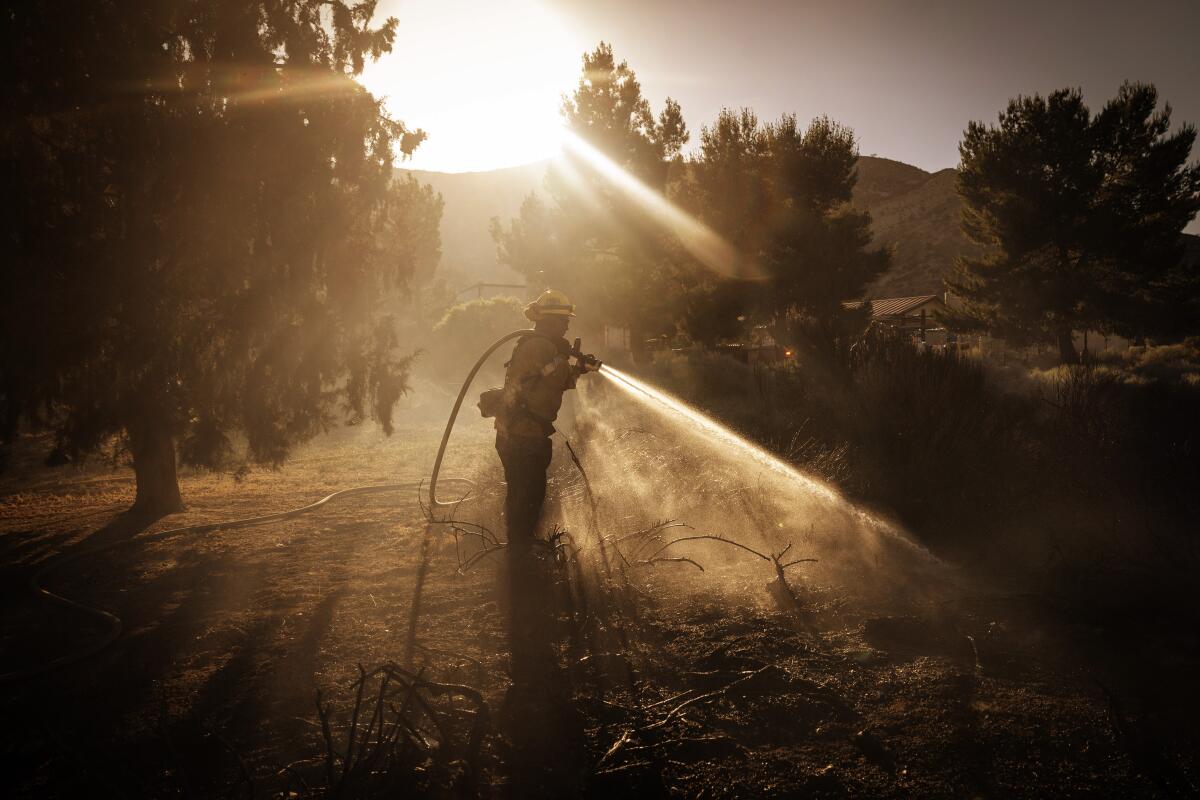Wildfires in California trigger air quality advisories. Here’s what to do

Smoke emanating from several California wildfires that started over the weekend is worsening air quality on both ends of the state and has prompted an advisory for Los Angeles County and Bay Area residents to take precautions and stay indoors.
In separate wildfire smoke advisories Monday, the South Coast and Bay Area air quality management districts stated that as a result of the Post and Point fires, respectively, the air is unhealthy for sensitive groups — including young people with developing lungs, people older than 65 and those with lung conditions — and people should avoid going outdoors.
The advisory in Southern California is in effect until 5 p.m. Monday and covers areas southeast of the fire in Santa Clarita, the San Fernando Valley and Angeles National Forest. The Bay Area advisory is in effect through Tuesday and includes the wine country in the North Bay hills in Napa, Sonoma and Solano counties.
The Post fire in Lancaster, the largest one in the state, has burned 14,625 acres and was 8% contained Monday morning. The Point fire in Sonoma County was 1,190 acres and 20% contained, Cal Fire said.
The fires were just two of several that broke out across the state over the weekend, prompting air quality concerns.
If you live in an area with common signs of poor air quality, such as hazy skies, ash accumulating on vehicles or the smell of smoke, the American Lung Assn. suggests staying indoors and creating a clean air space within your home.
When the air quality is poor
If you are in an area that’s affected by smoke, experts say you should limit your exposure by remaining indoors and avoiding vigorous physical activity.
The American Lung Assn. shares guidance on how you can keep the air inside your home clean through the duration of the advisory.
Do: Close the doors and windows. Place damp rags at the bottoms of doors or windows that could let in outside air.
Do: Dust or mop surfaces with a damp cloth, the Environmental Protection Agency says, to keep settled particles from getting back into the air.
Do: Stay cool by running fans or your central air conditioning. If your HVAC system or window air conditioner has a fresh-air option (that is, it pulls air from outside), turn it off and close the intake, or set the system to recirculate.
Do: Create a clean air space. This is an interior room where you can completely shut all doors and windows and run a HEPA air purifier. A HEPA purifier moves air through its filter to trap particles, odors and more without introducing anything into the air. These purifiers clean a certain amount of square footage, though, so when buying a purifier, make sure it can clean the air in the room you’ve chosen. Don’t use an ionizer air purifier in your clean air space because it can create ozone.
Don’t: Create smoke or bad air inside by smoking cigarettes, cigars or pipes; using gas, propane or wood-burning stoves or cookers; spraying aerosol products; frying or broiling food; burning candles or incense; and vacuuming, unless the vacuum has a HEPA filter.
Don’t: Go outside if you don’t have to. If you have to leave your home, wear an N95 mask if you have one; other face coverings are not as effective.
Don’t: If you made a DIY air purifier, do not leave it unattended.
Stay informed on air quality updates
If you’ve received an air quality advisory from local officials or live near a wildfire area, there are several ways to stay informed on how the fire is affecting the air in your community.
You can check these sources for up-to-date information and advisories:
- The South Coast Air Quality Management District has an air quality index map for Southern California. The map is color-coded to indicate whether the air is good, unhealthful or hazardous. It also has an app for Apple and Android devices that alerts users when the air quality is poor or when there’s an extreme event such as a fire. You can also get email alerts. There are local air quality districts throughout California, so identify yours and sign up for alerts.
- AirNow reports air quality using the official U.S. air quality index, a color-coded index designed to communicate whether air quality is healthful. You can enter your ZIP Code, city or state on the AirNow website, and it will show you the current air quality as well as a forecast.
During a wildfire, checking the air quality is important because weather conditions, particularly wind, can change the distribution of wildfire smoke.
Once the air clears
If there’s leftover ash and soot outside your home, it’s recommended that you wear gloves and an N95 mask while cleaning and disposing of it. The American Lung Assn. recommends that you wet the area to reduce the amount of particles becoming airborne.
Those with lung or heart problems should avoid cleanup activities.
More to Read
Sign up for Essential California
The most important California stories and recommendations in your inbox every morning.
You may occasionally receive promotional content from the Los Angeles Times.











